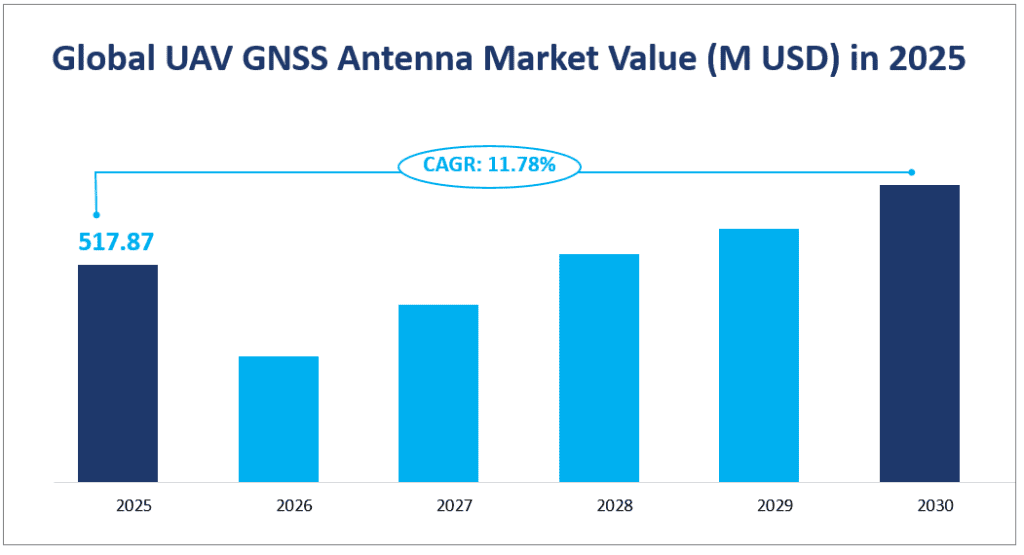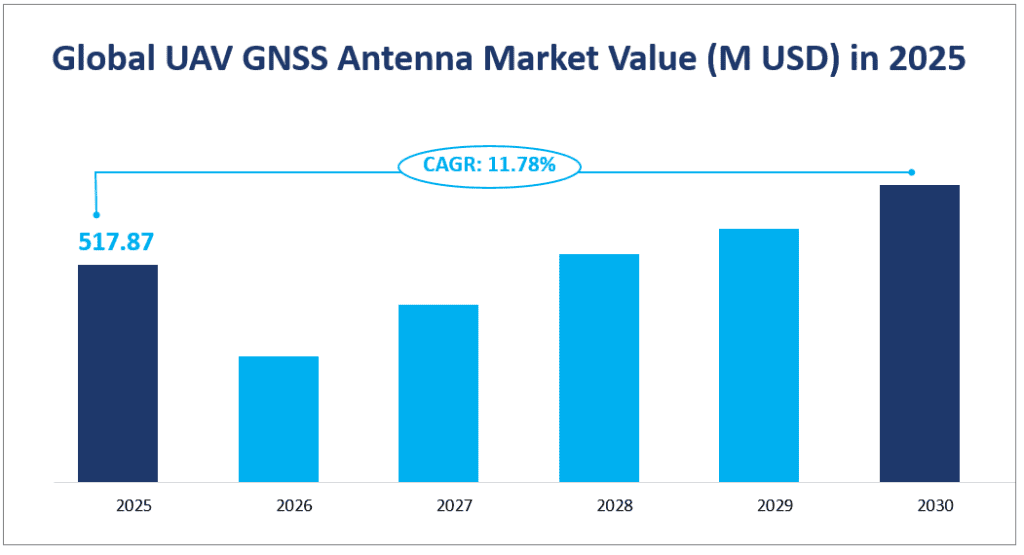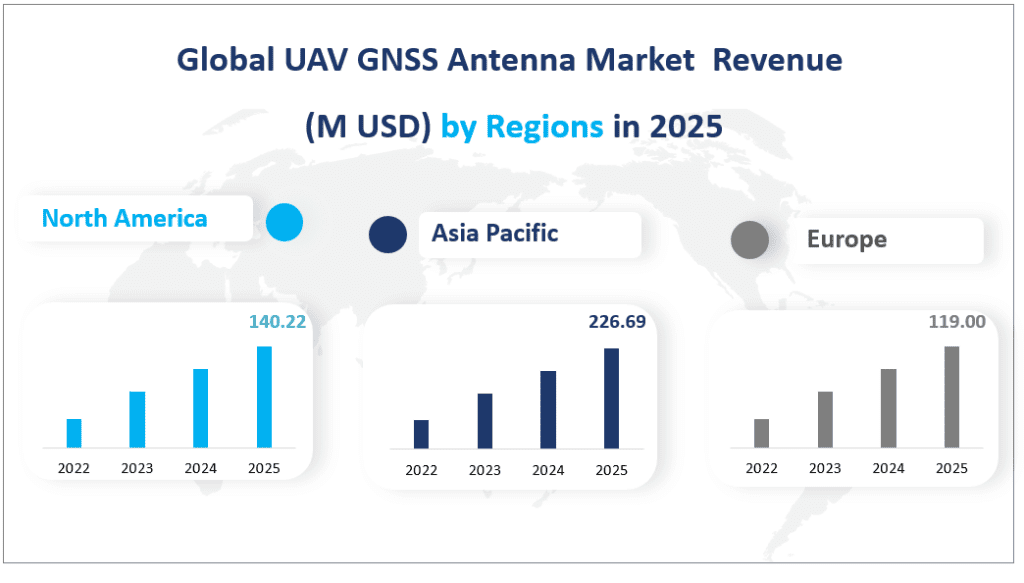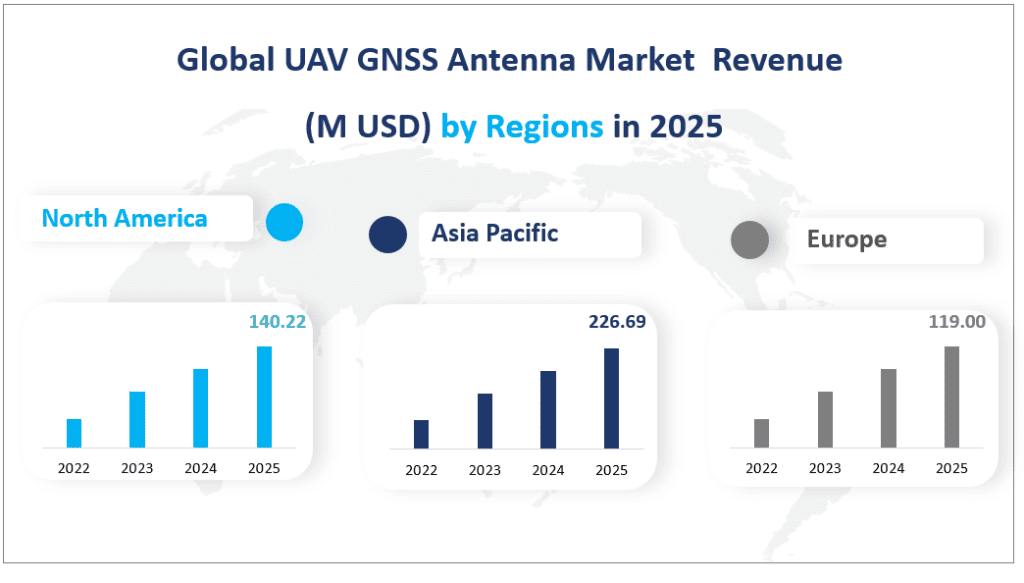1. Global UAV GNSS Antenna Market Definition
The global UAV GNSS Antenna market is projected to reach a revenue of $517.87 million in 2025 with a CAGR of 11.78% from 2025 to 2030.
A UAV GNSS Antenna is a critical component for Unmanned Aerial Vehicles (UAVs), commonly known as drones. These antennas receive signals from Global Navigation Satellite Systems (GNSS) such as GPS, GLONASS, Galileo, and BeiDou. These signals are essential for determining the UAV’s position, velocity, and timing. The antennas come in various types, including helix antennas and patch antennas, each with unique advantages. Helix antennas are known for their small size and lightweight, making them ideal for UAVs, while patch antennas are favored for their planar structure and ease of integration.
Global UAV GNSS Antenna Market Value (M USD) in 2025


2. Driving Factors of the UAV GNSS Antenna Market
Increasing Demand for UAVs: The market for UAVs is expanding rapidly, driven by their applications in various sectors such as agriculture, security, surveying, and logistics. UAVs are increasingly being used for tasks that are dangerous or difficult for humans, such as disaster monitoring and surveillance. This growing demand for UAVs directly translates into a higher demand for GNSS antennas, which are essential for navigation and positioning.
Technological Advancements: Advances in GNSS technology have led to the development of more accurate and reliable positioning systems. High-precision antennas capable of receiving signals from multiple satellite constellations are becoming more prevalent. These advancements enable UAVs to operate with greater accuracy and reliability, further driving the demand for GNSS antennas.
Government Support and Policies: Governments around the world are promoting the use of UAVs for various applications, including defense, disaster management, and agriculture. Policies that encourage the development and deployment of UAVs indirectly support the growth of the UAV GNSS Antenna market.
Civilian Applications: The civilian market for UAVs is growing rapidly, with applications ranging from aerial photography to precision agriculture. The increasing use of UAVs in these sectors is driving the demand for GNSS antennas, which are essential for ensuring the safe and effective operation of these devices.
3. Limiting Factors of the UAV GNSS Antenna Market
High Raw Material Costs: The production of GNSS antennas requires specialized materials such as high-frequency ceramics and polymer dielectrics. The cost of these materials can be high, which can impact the profitability of manufacturers. Additionally, fluctuations in the prices of raw materials can lead to increased production costs.
Regulatory Challenges: The operation of UAVs is subject to strict regulations in many countries. These regulations can limit the deployment of UAVs in certain areas or for specific applications. Regulatory hurdles can slow down the adoption of UAVs and, consequently, the demand for GNSS antennas.
Technical Complexity: The development and production of high-precision GNSS antennas require advanced technical expertise. The complexity of these antennas can lead to higher production costs and longer development times. Additionally, the need for continuous innovation to meet evolving market demands can be a challenge for manufacturers.
Competition: The UAV GNSS Antenna market is becoming increasingly competitive, with new entrants entering the market. This competition can lead to price pressures and reduced profit margins for existing players. Additionally, the need to differentiate products and offer unique value propositions can be challenging in a crowded market.
4. Analysis of UAV GNSS Antenna Market Segment
Product Types
Helix antennas are widely used in UAVs due to their compact size and lightweight design. These antennas are particularly suited for applications where weight and space are critical factors. In 2025, the market revenue for helix antennas is projected to reach $370.30 million.
Helix antennas offer several advantages, including their ability to provide accurate positioning data and their compatibility with multiple satellite constellations. Their small form factor makes them ideal for integration into various UAV designs, enhancing the overall functionality and performance of the drones. The market for helix antennas is expected to continue growing as UAV technology advances and the demand for precision navigation increases.
Patch antennas, on the other hand, are known for their planar structure and ease of integration. These antennas are typically used in applications where a larger surface area is available for installation. In 2025, the market revenue for patch antennas is projected to be $147.56 million.
Patch antennas are favored for their simplicity and cost-effectiveness. They are commonly used in civilian drone applications, such as agriculture and surveying, where the need for high-precision positioning is less critical compared to military applications. Despite their lower growth rate, patch antennas continue to play a significant role in the UAV GNSS Antenna market due to their versatility and ease of use.
Analysis of Different Applications
Military drones represent a significant portion of the UAV GNSS Antenna market. These drones are used for various purposes, including reconnaissance, surveillance, and combat operations. In 2025, the market revenue for UAV GNSS Antennas used in military drones is projected to reach $147.97 million.
The use of UAVs in military applications is driven by the need for advanced surveillance and reconnaissance capabilities. Military drones equipped with high-precision GNSS antennas can provide real-time data and intelligence, enhancing the effectiveness of military operations. The increasing investment in defense technology and the growing demand for advanced UAV systems are key drivers of the market for UAV GNSS Antennas in military applications.
Civilian drones, which include applications in agriculture, surveying, security, and logistics, represent the other major segment of the UAV GNSS Antenna market. In 2025, the market revenue for UAV GNSS Antennas used in civilian drones is projected to be $369.89 million.
Civilian drones are increasingly being used for a variety of applications, driven by advancements in UAV technology and the growing awareness of their potential benefits. In agriculture, UAVs equipped with GNSS antennas can be used for crop monitoring and precision farming. In surveying and mapping, UAVs provide accurate and efficient data collection. The increasing adoption of UAVs in these civilian applications is driving the demand for GNSS antennas.
In terms of market share, civilian drones hold the largest portion of the UAV GNSS Antenna market. Their dominance is attributed to the wide range of applications and the growing adoption of UAVs in various civilian sectors. The market share of civilian drones is expected to remain strong as the demand for UAVs in agriculture, surveying, and security continues to grow.
Market Revenue by Segment
| Market Revenue (M USD) in 2025 | ||
| By Type | Helix Antennas | 370.30 |
| Patch Antennas | 147.56 | |
| By Application | Military Drones | 147.97 |
| Civilian Drones | 369.89 |
5. Regional UAV GNSS Antenna Market
The Asia Pacific region is the largest market for UAV GNSS Antennas, with a projected revenue of $226.69 million in 2025. This region’s dominance is driven by rapid technological advancements, increasing demand for UAVs in various industries such as agriculture, surveying, and security, and the presence of major manufacturing hubs. The region also benefits from government initiatives promoting the use of UAVs for various applications, further fueling the demand for high-precision GNSS antennas.
North America is the second-largest market, with a projected revenue of $140.22 million in 2025. The United States and Canada are key players in this region, with a strong focus on defense, security, and advanced technological applications. The demand for UAVs in military and civilian applications is driving the market for GNSS antennas. The region is also known for its robust research and development infrastructure, which supports the continuous innovation and improvement of UAV technologies.
Europe is the third-largest market, with a projected revenue of $119.00 million in 2025. Countries such as Germany, France, and the UK are major contributors to the market. The European market is characterized by a strong emphasis on precision agriculture, environmental monitoring, and security applications. The region also benefits from favorable government policies and regulations that support the adoption of UAVs in various sectors.
Latin America is a smaller but growing market, with a projected revenue of $18.58 million in 2025. The demand for UAVs in agriculture, mining, and security applications is driving the market growth. The region is also experiencing increased investment in UAV technologies, driven by the need for efficient and sustainable agricultural practices and enhanced security measures.
The Middle East and Africa region is the smallest market, with a projected revenue of $13.38 million in 2025. The demand for UAVs in defense, security, and infrastructure monitoring is driving the market growth. The region is also benefiting from increased investment in UAV technologies, driven by the need for enhanced security and surveillance capabilities.
The Asia Pacific region is not only the largest market but also the fastest-growing region, with a CAGR of 12.38% from 2022 to 2028. This rapid growth is attributed to the region’s dynamic technological advancements, increasing demand for UAVs in various industries, and strong government support for UAV applications. The region’s robust manufacturing capabilities and innovation in UAV technologies are key drivers of its market growth.
Global UAV GNSS Antenna Market Revenue (M USD) by Regions in 2025


6. Analysis of Top 3 Companies in the UAV GNSS Antenna Market
Trimble is a leading provider of high-precision positioning solutions, with a strong focus on GNSS technology. The company offers a wide range of products, including the AV16, a helix-based, dual-frequency antenna designed for UAV applications. Trimble’s products are known for their lightweight, small form factor, and low power consumption, making them ideal for UAVs. Trimble’s market position is strengthened by its continuous innovation and commitment to providing high-quality, reliable solutions for UAV applications.
Hexagon is a global leader in sensor, software, and autonomous solutions. The company offers a comprehensive line of GNSS products, including the GPS-703-GGG-HV, a high-performance antenna suitable for UAVs. Hexagon’s products are known for their robustness, accuracy, and compatibility with multiple satellite constellations. Hexagon’s market position is bolstered by its extensive product portfolio and strong focus on innovation and customer satisfaction.
Taoglas is a leading provider of advanced antenna solutions, with a focus on high-performance GNSS antennas. The company offers products such as the GPDF6010.A, a multi-band passive high-precision GNSS antenna designed for UAVs. Taoglas’s products are known for their innovative design, high performance, and ease of integration. Taoglas’s market position is enhanced by its commitment to providing cutting-edge solutions and its ability to meet the evolving needs of the UAV industry.
Major Players
| Company Name | Plant Locations | Market Distribution |
| Trimble | Mainly in USA | Worldwide |
| Hexagon | Mainly in Canada | Worldwide |
| Taoglas | Mainly in Taiwan, China | Worldwide |
| Molex | Mainly in Asia and North America | Worldwide |
| Harxon | China | Worldwide |
| Tallysman | Mainly in Canada | Worldwide |
| 2J Antennas | Slovakia | Worldwide |
| PCTEL | China | Worldwide |
| San Jose Technology, Inc | China | Worldwide |
| Maxtena | Mainly in USA | Worldwide |
| Shenzhen Beitian Communication Co., Ltd | China | Mainly in Asia |
| ZHEJIANG JC Antenna Co.,Ltd | China | Mainly in Asia |
| Stonex | Mainly in Europe | Worldwide |
| MP Antenna | USA | Worldwide |
| Octane Wireless | USA | Worldwide |
| ARA | USA | Worldwide |
| PPM Systems | UK | Worldwide |
| Viasat | USA | Worldwide |
1 Study Coverage
1.1 UAV GNSS Antenna Product Introduction
1.2 Market by Type
1.2.1 Global UAV GNSS Antenna Market Size Growth Rate by Type
1.3 Market by Applications
1.3.1 Global UAV GNSS Antenna Market Size Growth Rate by Applications
1.4 Study Objectives
1.5 Years Considered
2 Executive Summary
2.1 Global UAV GNSS Antenna Sales Estimates and Forecasts
2.2 Global UAV GNSS Antenna Revenue Estimates and Forecasts 2017-2028
2.3 Global UAV GNSS Antenna Revenue by Region: 2017 VS 2022 VS 2028
2.4 Global Top UAV GNSS Antenna Regions by Sales
2.4.1 Global Top UAV GNSS Antenna Regions by Sales (2017-2022)
2.4.2 Global Top UAV GNSS Antenna Regions by Sales (2023-2028)
2.5 Global Top UAV GNSS Antenna Regions by Revenue
2.5.1 Global Top UAV GNSS Antenna Regions by Revenue (2017-2022)
2.5.2 Global Top UAV GNSS Antenna Regions by Revenue (2023-2028)
2.6 North America
2.7 Europe
2.8 Asia-Pacific
2.9 Latin America
2.10 Middle East & Africa
3 Competition by Manufacturers
3.1 UAV GNSS Antenna Sales by Manufacturers
3.1.1 Global Top UAV GNSS Antenna Manufacturers by Sales (2017-2022)
3.1.2 Global Top UAV GNSS Antenna Manufacturers Market Share by Sales (2017-2022)
3.1.3 Global Top 10 and Top 5 Companies by UAV GNSS Antenna Sales in 2021
3.2 UAV GNSS Antenna Revenue by Manufacturers
3.2.1 Global Top UAV GNSS Antenna Manufacturers by Revenue (2017-2022)
3.2.2 Global Top UAV GNSS Antenna Manufacturers Market Share by Revenue (2017-2022)
3.2.3 Global Top 10 and Top 5 Companies by UAV GNSS Antenna Revenue in 2021
3.3 Global UAV GNSS Antenna Sales Price by Manufacturers
3.4 Analysis of Competitive Landscape
3.4.1 Manufacturers Market Concentration Ratio (CR5 and HHI)
3.4.2 Global UAV GNSS Antenna Market Share by Company Type (Tier 1, Tier 2, and Tier 3)
3.4.3 Global UAV GNSS Antenna Manufacturers Headquarters
3.5 Mergers & Acquisitions, Expansion Plans
4 Market Size by Type
4.1 Global UAV GNSS Antenna Sales by Type
4.1.1 Global UAV GNSS Antenna Historical Sales by Type (2017-2022)
4.1.2 Global UAV GNSS Antenna Forecasted Sales by Type (2023-2028)
4.1.3 Global UAV GNSS Antenna Sales Market Share by Type (2017-2028)
4.2 Global UAV GNSS Antenna Revenue by Type
4.2.1 Global UAV GNSS Antenna Historical Revenue by Type (2017-2022)
4.2.2 Global UAV GNSS Antenna Forecasted Revenue by Type (2023-2028)
4.2.3 Global UAV GNSS Antenna Revenue Market Share by Type (2017-2028)
4.3 Global UAV GNSS Antenna Price by Type
4.3.1 Global UAV GNSS Antenna Price by Type (2017-2022)
4.3.2 Global UAV GNSS Antenna Price Forecast by Type (2023-2028)
5 Market Size by Application
5.1 Global UAV GNSS Antenna Sales by Application
5.1.1 Global UAV GNSS Antenna Historical Sales by Application (2017-2022)
5.1.2 Global UAV GNSS Antenna Forecasted Sales by Application (2023-2028)
5.1.3 Global UAV GNSS Antenna Sales Market Share by Application (2017-2028)
5.2 Global UAV GNSS Antenna Revenue by Application
5.2.1 Global UAV GNSS Antenna Historical Revenue by Application (2017-2022)
5.2.2 Global UAV GNSS Antenna Forecasted Revenue by Application (2023-2028)
5.2.3 Global UAV GNSS Antenna Revenue Market Share by Application (2017-2028)
5.3 Global UAV GNSS Antenna Price by Application
5.3.1 Global UAV GNSS Antenna Price by Application (2017-2022)
5.3.2 Global UAV GNSS Antenna Price Forecast by Application (2023-2028)
6 North America
6.1 North America UAV GNSS Antenna Market Size by Type
6.1.1 North America UAV GNSS Antenna Sales by Type (2017-2028)
6.1.2 North America UAV GNSS Antenna Revenue by Type (2017-2028)
6.2 North America UAV GNSS Antenna Market Size by Application
6.2.1 North America UAV GNSS Antenna Sales by Application (2017-2028)
6.2.2 North America UAV GNSS Antenna Revenue by Application (2017-2028)
6.3 North America UAV GNSS Antenna Market Size by Country
6.3.1 North America UAV GNSS Antenna Sales by Country (2017-2028)
6.3.2 North America UAV GNSS Antenna Revenue by Country (2017-2028)
6.3.3 U.S.
6.3.4 Canada
7 Europe
7.1 Europe UAV GNSS Antenna Market Size by Type
7.1.1 Europe UAV GNSS Antenna Sales by Type (2017-2028)
7.1.2 Europe UAV GNSS Antenna Revenue by Type (2017-2028)
7.2 Europe UAV GNSS Antenna Market Size by Application
7.2.1 Europe UAV GNSS Antenna Sales by Application (2017-2028)
7.2.2 Europe UAV GNSS Antenna Revenue by Application (2017-2028)
7.3 Europe UAV GNSS Antenna Market Size by Country
7.3.1 Europe UAV GNSS Antenna Sales by Country (2017-2028)
7.3.2 Europe UAV GNSS Antenna Revenue by Country (2017-2028)
7.3.3 Germany
7.3.4 France
7.3.5 U.K.
7.3.6 Italy
7.3.7 Russia
8 Asia Pacific
8.1 Asia Pacific UAV GNSS Antenna Market Size by Type
8.1.1 Asia Pacific UAV GNSS Antenna Sales by Type (2017-2028)
8.1.2 Asia Pacific UAV GNSS Antenna Revenue by Type (2017-2028)
8.2 Asia Pacific UAV GNSS Antenna Market Size by Application
8.2.1 Asia Pacific UAV GNSS Antenna Sales by Application (2017-2028)
8.2.2 Asia Pacific UAV GNSS Antenna Revenue by Application (2017-2028)
8.3 Asia Pacific UAV GNSS Antenna Market Size by Country
8.3.1 Asia Pacific UAV GNSS Antenna Sales by Country (2017-2028)
8.3.2 Asia Pacific UAV GNSS Antenna Revenue by Country (2017-2028)
8.3.3 China
8.3.4 Japan
8.3.5 South Korea
8.3.6 India
8.3.7 Australia
8.3.8 Taiwan
8.3.9 Southeast Asia
9 Latin America
9.1 Latin America UAV GNSS Antenna Market Size by Type
9.1.1 Latin America UAV GNSS Antenna Sales by Type (2017-2028)
9.1.2 Latin America UAV GNSS Antenna Revenue by Type (2017-2028)
9.2 Latin America UAV GNSS Antenna Market Size by Application
9.2.1 Latin America UAV GNSS Antenna Sales by Application (2017-2028)
9.2.2 Latin America UAV GNSS Antenna Revenue by Application (2017-2028)
9.3 Latin America UAV GNSS Antenna Market Size by Country
9.3.1 Latin America UAV GNSS Antenna Sales by Country (2017-2028)
9.3.2 Latin America UAV GNSS Antenna Revenue by Country (2017-2028)
9.3.3 Mexico
9.3.4 Brazil
9.3.5 Argentina
10 Middle East and Africa
10.1 Middle East and Africa UAV GNSS Antenna Market Size by Type
10.1.1 Middle East and Africa UAV GNSS Antenna Sales by Type (2017-2028)
10.1.2 Middle East and Africa UAV GNSS Antenna Revenue by Type (2017-2028)
10.2 Middle East and Africa UAV GNSS Antenna Market Size by Application
10.2.1 Middle East and Africa UAV GNSS Antenna Sales by Application (2017-2028)
10.2.2 Middle East and Africa UAV GNSS Antenna Revenue by Application (2017-2028)
10.3 Middle East and Africa UAV GNSS Antenna Market Size by Country
10.3.1 Middle East and Africa UAV GNSS Antenna Sales by Country (2017-2028)
10.3.2 Middle East and Africa UAV GNSS Antenna Revenue by Country (2017-2028)
10.3.3 Turkey
10.3.4 Saudi Arabia
10.3.5 U.A.E
11 Corporate Profile
11.1 Trimble
11.1.1 Company Corporation Information
11.1.2 Product Overview
11.1.3 Trimble UAV GNSS Antenna Production, Price, Revenue, Gross Margin
11.1.4 Business and Related Developments
11.2 Hexagon
11.2.1 Company Corporation Information
11.2.2 Product Overview
11.2.3 Hexagon UAV GNSS Antenna Production, Price, Revenue, Gross Margin
11.2.4 Business and Related Developments
11.3 Taoglas
11.3.1 Company Corporation Information
11.3.2 Product Overview
11.3.3 Taoglas UAV GNSS Antenna Production, Price, Revenue, Gross Margin
11.3.4 Business and Related Developments
11.4 Molex
11.4.1 Company Corporation Information
11.4.2 Product Overview
11.4.3 Molex UAV GNSS Antenna Production, Price, Revenue, Gross Margin
11.4.4 Business and Related Developments
11.5 Harxon
11.5.1 Company Corporation Information
11.5.2 Product Overview
11.5.3 Harxon UAV GNSS Antenna Production, Price, Revenue, Gross Margin
11.5.4 Business and Related Developments
11.6 Tallysman
11.6.1 Company Corporation Information
11.6.2 Product Overview
11.6.3 Tallysman UAV GNSS Antenna Production, Price, Revenue, Gross Margin
11.6.4 Business and Related Developments
11.7 2J Antennas
11.7.1 Company Corporation Information
11.7.2 Product Overview
11.7.3 2J Antennas UAV GNSS Antenna Production, Price, Revenue, Gross Margin
11.7.4 Business and Related Developments
11.8 PCTEL
11.8.1 Company Corporation Information
11.8.2 Product Overview
11.8.3 PCTEL UAV GNSS Antenna Production, Price, Revenue, Gross Margin
11.8.4 Business and Related Developments
11.9 San Jose Technology, Inc
11.9.1 Company Corporation Information
11.9.2 Product Overview
11.9.3 San Jose Technology, Inc UAV GNSS Antenna Production, Price, Revenue, Gross Margin
11.9.4 Business and Related Developments
11.10 Maxtena
11.10.1 Company Corporation Information
11.10.2 Product Overview
11.10.3 Maxtena UAV GNSS Antenna Production, Price, Revenue, Gross Margin
11.10.4 Business and Related Developments
11.11 Shenzhen Beitian Communication Co., Ltd
11.11.1 Company Corporation Information
11.11.2 Product Overview
11.11.3 Shenzhen Beitian Communication Co., Ltd UAV GNSS Antenna Production, Price, Revenue, Gross Margin
11.11.4 Business and Related Developments
11.12 ZHEJIANG JC Antenna Co.,Ltd
11.12.1 Company Corporation Information
11.12.2 Product Overview
11.12.3 ZHEJIANG JC Antenna Co.,Ltd UAV GNSS Antenna Production, Price, Revenue, Gross Margin
11.12.4 Business and Related Developments
11.13 Stonex
11.13.1 Company Corporation Information
11.13.2 Product Overview
11.13.3 Stonex UAV GNSS Antenna Production, Price, Revenue, Gross Margin
11.13.4 Business and Related Developments
11.14 MP Antenna
11.14.1 Company Corporation Information
11.14.2 Product Overview
11.14.3 Business and Related Developments
11.15 Octane Wireless
11.15.1 Company Corporation Information
11.15.2 Product Overview
11.15.3 Business and Related Developments
11.16 ARA
11.16.1 Company Corporation Information
11.16.2 Product Overview
11.16.3 Business and Related Developments
11.17 PPM Systems
11.17.1 Company Corporation Information
11.17.2 Product Overview
11.17.3 Business and Related Developments
11.18 Viasat
11.18.1 Company Corporation Information
11.18.2 Product Overview
11.18.3 Business and Related Developments
12 Value Chain and Sales Channels Analysis
12.1 UAV GNSS Antenna Value Chain Analysis
12.2 UAV GNSS Antenna Key Raw Materials and Suppliers Analysis
12.2.1 UAV GNSS Antenna Key Materials Suppliers
12.2.2 Global UAV GNSS Antenna Market Size and Growth by Raw Material Type (2017-2028)
12.2.3 Global UAV GNSS Antenna Consumption and Growth by Raw Material Type (2017-2028)
12.3 UAV GNSS Antenna Production Mode & Process
12.4 UAV GNSS Antenna Sales and Marketing
12.4.1 UAV GNSS Antenna Sales Channels
12.4.2 UAV GNSS Antenna Distributors
12.5 UAV GNSS Antenna Customers
13 Market Drivers, Opportunities, Challenges and Risks Factors Analysis
13.1 UAV GNSS Antenna Industry Trends
13.2 UAV GNSS Antenna Market Drivers
13.3 UAV GNSS Antenna Market Challenges
13.4 UAV GNSS Antenna Market Restraints
14 Key Findings in The Global UAV GNSS Antenna Study
15 Appendix
15.1 Methodology
15.2 Research Data Source
15.2.1 Secondary Data
15.2.2 Primary Data
15.2.3 Market Size Estimation
15.2.4 Legal Disclaimer
